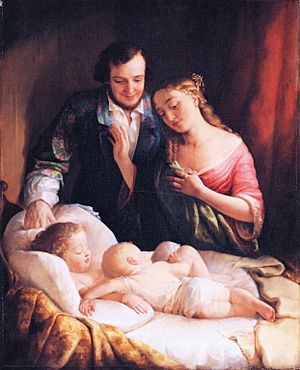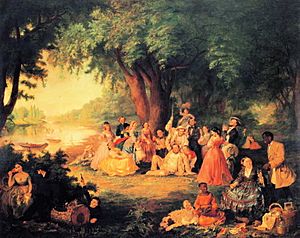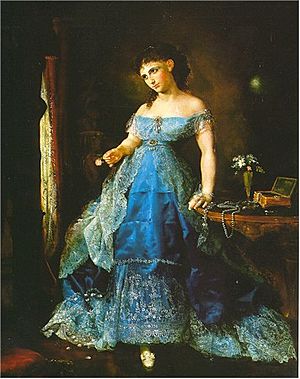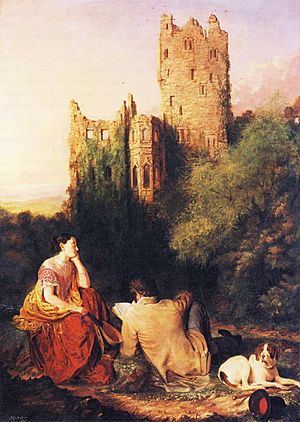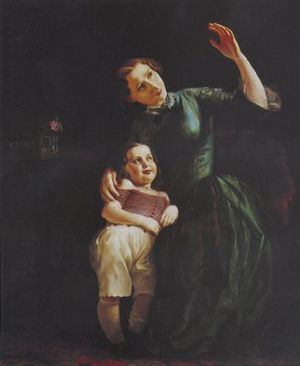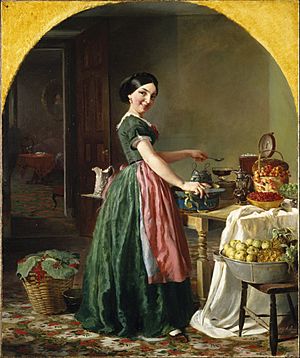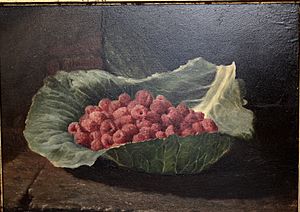Lilly Martin Spencer facts for kids
Quick facts for kids
Lilly Martin Spencer
|
|
|---|---|
 |
|
| Born |
Angelique Marie Martin
November 26, 1822 Exeter, United Kingdom
|
| Died | May 22, 1902 (aged 79) New York, New York
|
| Nationality | American |
| Known for | Painting |
| Movement | Genre Painting |
| Spouse(s) | Benjamin Rush Spencer |
Lilly Martin Spencer (born Angelique Marie Martin; November 26, 1822 – May 22, 1902) was a very popular American painter in the mid-1800s. She was known for her "genre paintings," which are artworks showing scenes from everyday life. Lilly often painted happy family moments, especially women and children in warm, cozy settings.
Over her career, she also painted different subjects, including portraits of famous people. One notable portrait was of Elizabeth Cady Stanton, a leader in the movement for women's right to vote. Even though many people liked her art, Lilly Martin Spencer often struggled to earn enough money as a professional painter. She faced financial challenges for most of her adult life.
Contents
Biography of Lilly Martin Spencer
Early Life and Artistic Beginnings

Lilly Martin Spencer was born in Exeter, England. Her parents, Gilles Marie Martin and Angelique Perrine LePetit Martin, were from France. In 1830, when Lilly was eight, her family moved to New York City. They lived there for three years before settling in Marietta, Ohio.
Lilly was taught at home by her well-educated parents. This is where her long journey as an artist began. Her first artworks were drawings of her family members. She drew them on the walls of their home, showing them in lively poses. Instead of being upset, her parents encouraged her love for art. They believed in more opportunities for women, which was unusual for the time.
Lilly kept drawing, and her work was so good that people started visiting their farm. They wanted to see her amazing pictures for themselves. This encouragement made her want to draw even more. However, it was hard for her to find proper art supplies and a good teacher.
Despite these challenges, local artists noticed her talent. They helped her, especially with adding color to her charcoal drawings. Two important mentors were Sala Bosworth and Charles Sullivan, both trained artists. Lilly's first art show was in August 1841 at a church. There, she caught the eye of Nicholas Longworth, who helped many artists. He called her "a new genius."
Longworth offered to send Lilly to Boston for more training. But Lilly decided to go to Cincinnati with her father instead. Cincinnati was full of artists, and Lilly spent the next seven years studying there. This time was very productive for her. She turned down Longworth's offer to study in Europe. Instead, she learned from local artists like James Beard and John Insco William. Lilly was unique because most women at that time used art as a hobby, not a career. But Lilly chose to be a professional artist.
Married Life and Career
In 1844, Lilly married Benjamin Rush Spencer in Cincinnati. Benjamin was from England and worked as a tailor. After they married, he stopped his own career to help his wife. He helped with household tasks and her art business. This meant Lilly became the main person earning money for their family.
Even though their home life was not traditional, they were very happy together. Lilly and Benjamin had thirteen children, and seven of them lived to adulthood. Many people thought getting married would end her art career. But it didn't! She became one of the most popular female painters of everyday scenes in the mid-1800s.
The Spencers often had money problems. To find better opportunities, they moved to New York City in 1848. Lilly was already known there from her art shows. In New York, middle-class families wanted to buy art that showed scenes they could relate to. Lilly Martin Spencer was perfect for this. She painted domestic scenes, often using her own family and pets as models.
In 1849, she created her first big successful painting, Life's Happy Hour. Experts say that Lilly was able to be both an artist and a mother successfully. Her paintings were always positive and happy. They showed sweet scenes of home life. Her art from this time often made viewers feel included, like they were part of a friendly joke.
Despite her popularity, Lilly still struggled financially. She sold many prints of her paintings, but she usually only made money from selling the rights to the artwork, not from each print sold. She also drew pictures for books and magazines like Godey's Lady's Book. Because it was hard to make ends meet, the Spencers moved to Newark, New Jersey in 1858. There, they raised chickens and grew vegetables to help feed their family. Lilly continued to paint portraits and take on special art jobs. She supported her family through her art, but money was always a concern.
During the 1860s, the American Civil War changed how many artists saw the world. Lilly's paintings became more thoughtful and included patriotic themes. She painted famous works like War Spirit at Home (1866) and We Both Must Fade (1869). The latter shows a young woman looking in a mirror. Its title suggests ideas about the importance of beauty for women and their roles in society during that time.
During this period, she painted what she considered her best work, Truth Unveiling Falsehood. This painting is divided into two parts. On one side, a scary-looking woman with a sheep's head is about to harm a baby. On the other side, a beautiful woman is caring for a child. An angelic figure named Truth lifts a cloak off the monster, showing it as "Selfishness." Lilly did not paint this for a client, and she refused to sell it even for a lot of money. The painting's meaning is still debated today, and it's her only work with a symbolic message.
Later Life and Legacy
In the winter of 1879–80, Lilly's family moved again to a rural area in Highland, Ulster County, New York. Her paintings started to show more details of landscapes and farm life. In the 1880s, Spencer tried to show her work to the public again. But she found that the art market had changed a lot since the Civil War. Rich people were now buying "serious" European art, not the kind of art Lilly made. Her art dealer told her that her skill was still great, but clients were buying "great Foreign names." She kept trying to sell her work, but her style was no longer as popular.
Her husband, Benjamin, passed away in 1890 after forty-six years of marriage. Lilly sold their farm and moved to another farm nearby. She kept a studio in town. Lilly Martin Spencer continued to work, but her money situation remained difficult. Sometimes, she had to pay for services with her art. She worked until the day she died on May 22, 1902. She was buried in Highland Cemetery in Highland, New York.
Lilly Martin Spencer had an art career that lasted over 60 years. She painted portraits of important people, including First Lady Caroline Harrison and the women's rights activist Elizabeth Cady Stanton. She kept going despite money problems and the challenges of being a female artist in a world mostly run by men.
Artistic Style of Lilly Martin Spencer
Lilly Martin Spencer usually painted with oil on canvas. Her paintings varied in size, from very large to quite small. Her ideas for paintings came from her own home and family. She often showed perfect-looking children, mothers who looked like the Virgin Mary, happy homemakers, and lovable but clumsy husbands.
Her art was seen as both encouraging people to fit into middle-class life and also showing a perfect world where everyone was equal. She was often inspired by etiquette books, which are guides on good manners. This made her pay close attention to details in her settings, like bowls of fruit or pretty flower arrangements. Etiquette also influenced what people in her paintings were doing. Women were shown doing "womanly" activities, and everyone played their traditional roles.
Spencer used bright, clear colors in her paintings. Her artworks were carefully made and had smooth finishes. In her later years, her brushstrokes became a bit looser. Her paintings usually had short, catchy titles that were more like exclamations than descriptions.
One common comment about her work was that the heads of her figures sometimes looked larger than their bodies. For example, in Shake Hands? (1854), a painting at the Ohio Historical Society, a cheerful woman is making dough in a cozy kitchen. She pauses from her work, smiling broadly, and reaches out to greet someone, perhaps the viewer. The title is clever because you wouldn't want to shake hands with someone covered in dough!
This painting also has a deeper meaning about equality. Shaking hands was a symbol of equality for men. Here, a woman is claiming her own kind of equality, even if it's within the home. Spencer showed that a woman's world, though separate, could be a happy and powerful place. She suggested that women's domestic work was not just useful but also enjoyable. The woman in the painting is confident and in control of her kitchen. Spencer played with traditional ideas about women's roles and added deeper meaning to them.
Selected Works
- The Little Navigator (1848)
- Domestic Happiness (1848), Detroit Institute of Arts
- The Young Teacher (1848)
- Life's Happy Hour (1849)
- The Jolly Washerwoman (1851), Hood Museum of Art
- Peeling Onions (1852), Memorial Art Gallery, Rochester, NY
- Reading the Legend (1852), Smith College Museum of Art
- The Young Husband: First Marketing (1854)
- Shake Hands? (1854), Ohio Historical Society
- Clap Hands (1855)
- The Forsaken (1856), The Smithsonian Collection L.M Spencer exhibit (1973), location currently unknown
- The Young Wife: First Stew (1856)
- Kiss Me and You'll Kiss the 'Lasses (1856), Brooklyn Museum of Art
- This Little Pig Went to the Market (1857)
- Fi!Fo!Fum! (1858)
- Raspberries on a Leaf (1858), Collection: Widener University Alfred O. Deshong Collection
- Grandpa's Prodigies (1860)
- War Spirit at Home: Celebrating the Battle at Vicksburg (1866)
- Mother and Child by the Hearth (1867)
- We Both Must Fade (Mrs. Fithian) (1869), Smithsonian American Art Museum
- Old Man with Two Children (1845), Collection: purchased at auction in 1958 by the Ohio Historical Center, Columbus.
- Peeling Onions (1848–1852) Collection: Hirschl & Adler Galleries, New York; to Closson Galleries, Cincinnati; to Munson-Williams-Proctor Institute, Utica
- Self-Portrait (ca. 1841), Collections: Mrs. Pierre A. G. Spencer; in 1947 to the Ohio Historical Center, Columbus
- Shepherdess Mending Stockings (1844–1848), Collections: Mrs. William E. Smith, Oxford, Ohio (1953); given by Mrs. Smith in 1870 to the Ohio Historical Center
- Young Women in a Seventeenth-Century Costume (1845), Collection: Mrs. Mary Abrams, Llewellyn Park, New Jersey
- Child Playing with Fish Bowl (1856), Collection: Victor Sparks, New York; to Mrs. George L. Cohen, New York; given by Mrs. Cohen in 1966 to the Newark Museum
- Choose Between (ca. 1857), Collections: John Mitchell, New York; to Victor Spark (1946); private owner; Victor Spark, New York
- Peeling Onions (ca. 1852), Collection: Mr. and Mrs. William Postar, Boston
- Reading the Legend (1852), Collections: Visitor Spark, New York (1843); to M. Knoedler &Co.; to Caroline R. and Adeline F. Wing; given by the Misses Wing in 1954 to the Smith College Museum of Art, Northampton, Massachusetts
Exhibitions
- St. Luke's Episcopal Church (Marietta, Ohio), Rectory. 1841
- Metropolitan Museum of Art. Life in America: A Special Loan Exhibition of Paintings, April 24-October 29, 1939.
- Corcoran Gallery of Art (Washington, D.C.) American Processional: The Story of Our Country, July 8-December 17, 1950
- Currier Art Gallery of Art (Manchester, N.H.) 19th Century American Painting from the Collection of Henry Melville Fuller, September 18-October 17, 1971
- Walter Art Gallery (Baltimore). Old Mistresses: Women Artists of the Past, April 17- June 18, 1972
- Brooklyn Museum (Brooklyn, NY) Kiss Me and You'll Kiss the 'Lasses [1]
- National Academy of Design
- Women's Pavilion of the Philadelphia Centennial Exhibition in 1876
Images for kids
See also
 In Spanish: Lilly Martin Spencer para niños
In Spanish: Lilly Martin Spencer para niños


